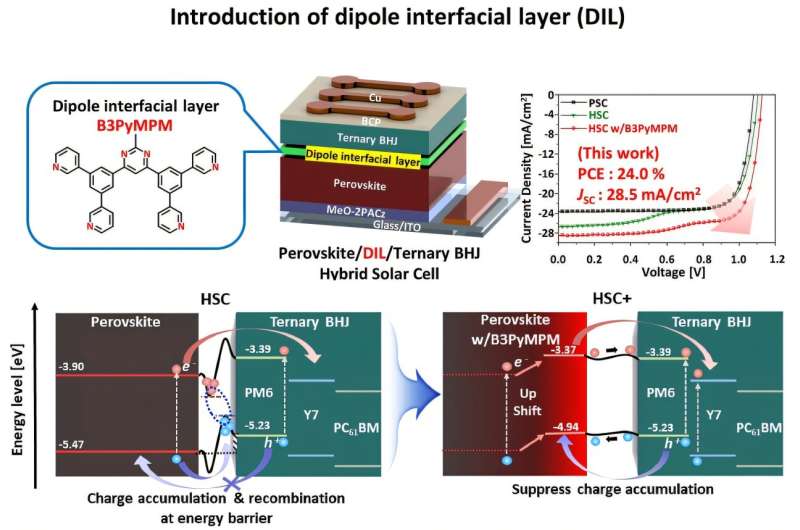
October 31, 2024 by KAIST
Collected at: https://techxplore.com/news/2024-10-generation-perovskite-solar-cell-absorb.html
Existing perovskite solar cells, which are unable to utilize approximately 52% of total solar energy, have been improved upon by a Korean research team. The team has developed an innovative technology that maximizes near-infrared light capture performance while greatly improving power conversion efficiency. This greatly increases the possibility of commercializing next-generation solar cells and is expected to contribute to important technological advancements in the global solar cell market.
The research team of Professor Jung-Yong Lee of the School of Electrical Engineering at KAIST and Professor Woojae Kim of the Department of Chemistry at Yonsei University announced on October 31 that they have developed a high-efficiency and high-stability organic-inorganic hybrid solar cell production technology that maximizes near-infrared light capture beyond the existing visible light range. Their study is published in the journal Advanced Materials.
The research team suggested and advanced a hybrid next-generation device structure with organic photo-semiconductors to complement perovskite materials limited to visible light absorption and expand the absorption range to near-infrared.
In addition, the researchers examined the electronic structure problem that mainly occurs in the structure and announced a high-performance solar cell device that dramatically solves this problem by introducing a dipole layer.
Existing lead-based perovskite solar cells have a problem in that their absorption spectrum is limited to the visible light region with a wavelength of 850 nanometers (nm) or less, which prevents them from utilizing approximately 52% of the total solar energy.
To solve this problem, the research team designed a hybrid device that combined an organic bulk heterojunction (BHJ) with perovskite and implemented a solar cell that can absorb up to the near-infrared region.
In particular, by introducing a sub-nanometer dipole interface layer, they succeeded in alleviating the energy barrier between the perovskite and the organic bulk heterojunction (BHJ), suppressing charge accumulation, maximizing the contribution to the near-infrared, and improving the current density (JSC) to 4.9 mA/cm2.
The key achievement of this study is that the power conversion efficiency (PCE) of the hybrid device has been significantly increased from 20.4% to 24.0%. In particular, this study achieved a higher internal quantum efficiency (IQE) than previous studies, reaching 78% in the near-infrared region.
In addition, this device showed high stability, showing excellent results of maintaining more than 80% of the initial efficiency in the maximum output tracking for more than 800 hours even under extreme humidity conditions.
Professor Lee said, “Through this study, we have effectively solved the charge accumulation and energy band mismatch problems faced by existing perovskite/organic hybrid solar cells, and we will be able to significantly improve the power conversion efficiency while maximizing the near-infrared light capture performance, which will be a new breakthrough that can solve the mechanical-chemical stability problems of existing perovskites and overcome the optical limitations.”
More information: Min‐Ho Lee et al, Suppressing Hole Accumulation Through Sub‐Nanometer Dipole Interfaces in Hybrid Perovskite/Organic Solar Cells for Boosting Near‐Infrared Photon Harvesting, Advanced Materials (2024). DOI: 10.1002/adma.202411015
Journal information: Advanced Materials

Leave a Reply